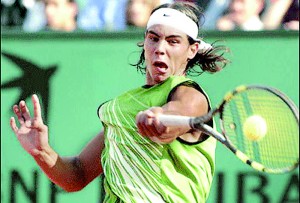Love, lust and reality of Tennis Racquets
View(s):In the 70’s, the longest winning streak of Guillermo Villas of Argentina with 53 wins, came to a halt when Ille Nastase of Romania beat him using the ‘double string’ racquet.
It gave too much spin and was immediately banned in competitions. To my knowledge, apart from this, there is no rule as to what a racquet should be in Tennis. Even a frying pan is ok if you can win. A good racquet is not a substitute for skills. Good players win because of their ability and would do so even with a frying pan.
 European Clay court circuit is on now. Players will prepare their racquets to play a ‘heavy ball’ which spins the ball furiously to curtail opponents on clay courts, but with a single string.
European Clay court circuit is on now. Players will prepare their racquets to play a ‘heavy ball’ which spins the ball furiously to curtail opponents on clay courts, but with a single string.
Reality of equipment
Tennis demands good racquets and its handling ability – in other words, a good frame, stringing and grip. All have equal impact in the rating of a racquet.
In the post war era, two aspects of the racquet changed the nature of the game. Synthetic material which replaced wood, gave a wider scope to produce larger frames. Wooden frames were 85sq.ins. While the synthetic frames average 98sq.ins and the biggest is 110sq.ins. The synthetic material and designs from aeronautical technology have made Racquets an incredible instrument. They are lighter and stronger. The design also took away all the ill effects of ‘contact shock’. All these changed the power base of Tennis. The top players have their frames made in special factories. They are heavy, very good but expensive. I acquired some and found it good to play with.
Strings and stringing
Why are they called ‘Guts?’ Originally all racquet guts came from animal intestines, hence the name. Today they are synthetic and called ‘strings’. Unlike the natural gut, synthetics are sensitive to string. When a racquet is strung well, elasticity should give power and tension the control to the ball on contact. Here is a simple guide – racquets have a prescribed tension range; high end provides good control and reduces power; lower end the opposite; larger frames give more power and less control; frames with 16 mains give more power and little control; 18 and 20 mains give more control; strings too have thickness to choose from. Too lower tension will create trampoline effect and make the ball contact- duration long. The shock then comes through to the arm giving joint pains. Stringing is personal. Try out a few methods and settle for one. Never change.
The grip
Racquet grip causes more discomfort to players than anything else. It is all about ‘a feel’. Racquet has to be the extension of the arm to sense the ball and lead us to our comfort zone. For this reason grip is another important aspect of the racquet. Any discomfort here means loss of comfort zone. All Racquet grips have 8 facets. When the two larger facets are broader the grip is ‘flatter’. If they are small the grip is ‘rounder’. If you have a large palm, go for a flatter grip. If you have shorter fingers round is better. To get more ‘feel’ do not use over grip. Most of the top players do not use them. Cushioning gives comfort and eliminates ‘feel’. [Yes, you will have blisters first. Apply diluted sprits and harden them]
Grip size
What is your grip size? It is simple to determine – hold your fingers together and bend to make a right angle with your palm, measure from the tip of the middle finger to the bend, with a foot ruler. That is your grip size in inches. If that is difficult, hold the grip with the middle finger and thumb. When the first knuckles of the finger and thumb touch, you have the right size. Large grip will tire your hand quickly. Small grip will rotate the Racquet with ball contact.
Love and lust
‘Sports equipment’ is a multibillion dollar industry employing a sizable number worldwide. Love for ‘new model’ comes up regularly as the industry puts them out to survive. They are also lusty with attractive motives and names attached. If you are a good player, watch out. Every time you change, nearly two years of development will be lost and you will need 4 months to come back. Change of equipment is a process, when done badly will give bad effects including joint pains and muscle tear. If you want to replace your racquet, get one similar to the previous one. Also, if you want play Tennis all your life, take this seriously.

Rafael Nadal enjoys a healthy winning streak
Illusion
Good players- do they change racquets? It does look like that but they do not. Then what do we see? It is one of the best kept secrets of modern Tennis. I am not talking!
Change only when necessary
Equipment must be good, that includes shoes too. Remember, Tennis is a skill. Be wise not to lose your comfort zone in skills, with changes in equipment. Change only to enhance, but not to lose your winning game. My recommendation is to stay with the ‘Racquet type’ that gave you comfort. No one has improved their game changing equipment. Skills are personal and not an external influence!
-georgepaldano@yahoo.com
Follow @timesonlinelk
comments powered by Disqus





















